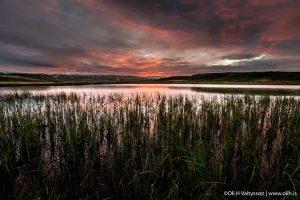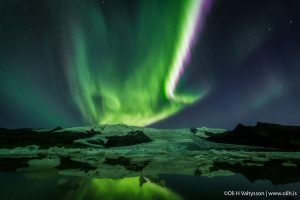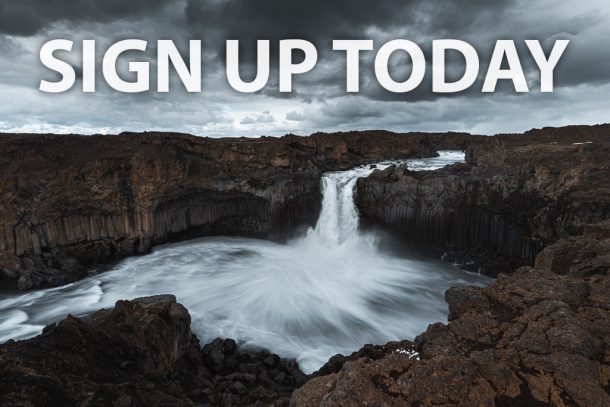
Imagine that you are standing just under the Arctic Circle. It’s almost 2AM, you’re admiring the mind-blowing colours of the midnight sun. Wind speed is around average, 10-15m/s, temperature is 10°C (50°F). You have been standing here for a few hours already, waiting for the perfect light conditions. You experienced some showers an hour ago, but it has gone fast. Now it’s sunshine, but the wind ensures that you have a larger amount of moisture from the waterfall all over you.
Now imagine that it’s winter, 9o’clock in the evening but it has been dark already for 4 hours. It’s -8°C (19.4°F) wind speed is around average again. You are standing in deep snow and waiting for the Northern Lights. It’s your third night without any success, but forecasts are promising for tonight so you want to keep on all night if you must.
 These are ordinary moments from our photo workshops in Iceland with usual weather conditions. Nature and landscape photography can be a challenging profession when it comes to standing outside for hours in terrible weather. Iceland is truly the Paradise for shooting amazing landscape photographs but it can also be the frozen hell for the photographer behind that camera. With all your power, you are trying not to leave your comfort zone too far since you need to think and focus on your work. You can’t capture that perfect moment with shaking hands, having fever, being in pain and suffering. Moreover, you can’t even reach the most unique spots if you are not equipped for the local conditions.
These are ordinary moments from our photo workshops in Iceland with usual weather conditions. Nature and landscape photography can be a challenging profession when it comes to standing outside for hours in terrible weather. Iceland is truly the Paradise for shooting amazing landscape photographs but it can also be the frozen hell for the photographer behind that camera. With all your power, you are trying not to leave your comfort zone too far since you need to think and focus on your work. You can’t capture that perfect moment with shaking hands, having fever, being in pain and suffering. Moreover, you can’t even reach the most unique spots if you are not equipped for the local conditions.
Understanding the Icelandic weather
Since Iceland lies in the path of the North Atlantic and the Irminger Current, its climate is more temperate than it would be expected for its latitude. The weather can be characterised rather as notoriously variable than as cold. Temperatures in winter (November-March) can be even milder than in Central and North Europe with an average around -5°C to +5°C (23-41 °F), in summer (June-August) the average temperatures are between 7-20°C (44-68 °F). Precipitation peaks from October to February, but the most dominating weather factor is the wind. We have 56 different words to describe it! Average wind speed is around 5-26 mph (8-41km/h) most of the time but there are 20-22 days a year with 40 mph (64km/h) gale speed or stronger.
What to wear on a tour in Iceland?
There is a stock phrase that you probably know already: „There’s no such thing as bad weather, only unsuitable clothing’. All participants of our tours can affirm that. The key of suitable clothing is not to dress warm, but to dress in layers! The following 3 main layers have all their own exact function that are not irreplaceable or skippable.
Base layer
The layer next to your skin: it is principal to wear long underwear set and good socks as a base layer. Its main function is to keep your skin always dry. Make sure you choose good quality, fast drying, fine wool, or synthetic fabric that was especially designed for base layer. Avoid cotton because it stays wet and cools your skin. In winter, you can wear polar fabric as a base layer for good insulation, but light, thinner material is preferred in summer.
Middle layer
The role of the middle layer is insulation. It protects you from the cold through keeping and reflecting the heat of your body: use a light, long sleeve thermal sweater in summer and a thicker polar or even more a duck down jacket in winter. As trousers pick insulated hiking pants as middle layer or a water-and windproof, insulated pants as 2in1 middle-and shell layer.
Outer layer
The shell or outer layer shields you from the actual weather elements, wind, and rain. Make sure your coat and trousers are made from real water-and windproof quality material. Choose a jacket with a well-fitting, adjustable hood. You can use a water repellent, windproof soft shell jacket and pants, but in this case, keep an extra layer of raincoat and trousers with you that you take on when it’s needed. It’s mandatory to have good, 100% waterproof preferably leather or Gore-Tex hiking boots, insulated ones in winter.
Some useful accessories that can make everything easier
- Gaiters and rubber boots are must-have accessories when shooting on the coastal areas or muddy, soggy locations.
- Bare head can largely reduce heat sensation, especially in windy conditions. Don’t forget your cap, and get a ski balaclava if you are sensitive. It’s an everyday thing in Iceland.
- If not balaclava, get a neck gaiter or a scarf. Try to avoid those huge, stifling ones that are everywhere in your face and get one from thin but warm thermal material and hide it under your jacket.
- Gloves! They are extremely important when it comes to taking photos in Iceland. It’s good if they are wind-and waterproof. To handle the camera, they must be either fingerless or with removable fingers at least on the forefinger and thumb. There are gloves that are designed especially for photographers. Try to get one of those or similar.
- Sunglasses can be lifesaving at some point. It doesn’t matter that it’s winter or summer, if sun is shining, it always can be sharp and disturbing. As your camera needs filters, so do your eyes. Talking of it, you may need sunscreen as well in summer.
- If you are not from a northern country, your skin may be reacting with a shock to the unknown climate. Go to the pharmacy and get a hard-core lip and hand balm to avoid all the uncomfortable symptoms that can be caused by arctic wind.
- We have excellent water quality in Iceland. There is no need to buy bottled water if you have your own water bottle, you can enjoy the pure tap water and save the nature from plastic.
- Yes, it is a highly professional photography tour/workshop but… would you be able to leave Iceland without having a bath in one of the natural hot springs or amazing swimming pools? Of course, not! Do not forget your swimming suit!
- Sometimes we leave the car behind and walk off the road to find the best spots to shoot and spend uncertain time there to wait for the optimal light conditions. You may need a daypack to carry your most necessary belongings.
The ultimate packing checklist for your Icelandic trip
After years of experiences in guiding professional photo tours with participants from all over the world, we have our own, tried-out and tested packing list that we send to our customers before they are heading to Iceland. Regarding our reviews, they were all more than satisfied even in the worst weather conditions. We decided to publish this list to make it easier for everyone. Just follow the local’s advice and you can focus on your work instead of the weather.
Clothing for the tours
- Waterproof hiking boots
- Wool hiking socks
- Gaiters are recommended in winter
- Rubber boots are required in any season
- Wool or specialized synthetic long underwear pants OR
- Thermal underwear in winter
- Wool or specialized synthetic long sleeve shirt OR
- Thermal underwear in winter
- Wool or synthetic T-shirt in summer
- Wool or thermal sweater as insulation layer
- Down jacket in winter
- Water-and windproof hiking pants, insulated ones in winter OR
- Windproof and water-repellent softshell trousers + extra layer of rain trousers
- Water-and windproof jacket with an adjustable hood OR
- Windproof and water-repellent softshell jacket + extra layer of raincoat
- Water-and windproof photographer’s gloves
- Warm and at least windproof hat
- Balaclava is recommended in winter
- Thin but warm scarf or neck gaiter
Recommended accessories
- Gaiters and rubber boots
- Cap
- Ski balaclava
- Neck gaiter or scarf
- Photographers gloves
- Sunglasses
- Water bottle
- Swimming suit
- Daypack
Optional accessories and personal items
- Toiletries (toothbrush, nail clippers, deodorant, etc.)
- Sunscreen
- Lip balm
- Hand balm
- Medication
- Swimming suit and towel
- Overnight T-shirt (Icelandic houses and hotels are very well heated, you don’t have to worry about cold nights during our tours)
Necessary documents
- Passport/ID/Driving licence
- Credit/debit card
As all the shootings will be outdoors, it’s highly recommended to get all of your clothing from an outdoor gear store. The seller can help you to select your outfit carefully and reasonably. If you have any questions regarding weather and clothing before the tour, don’t hesitate to contact us! See you in Iceland!
0




